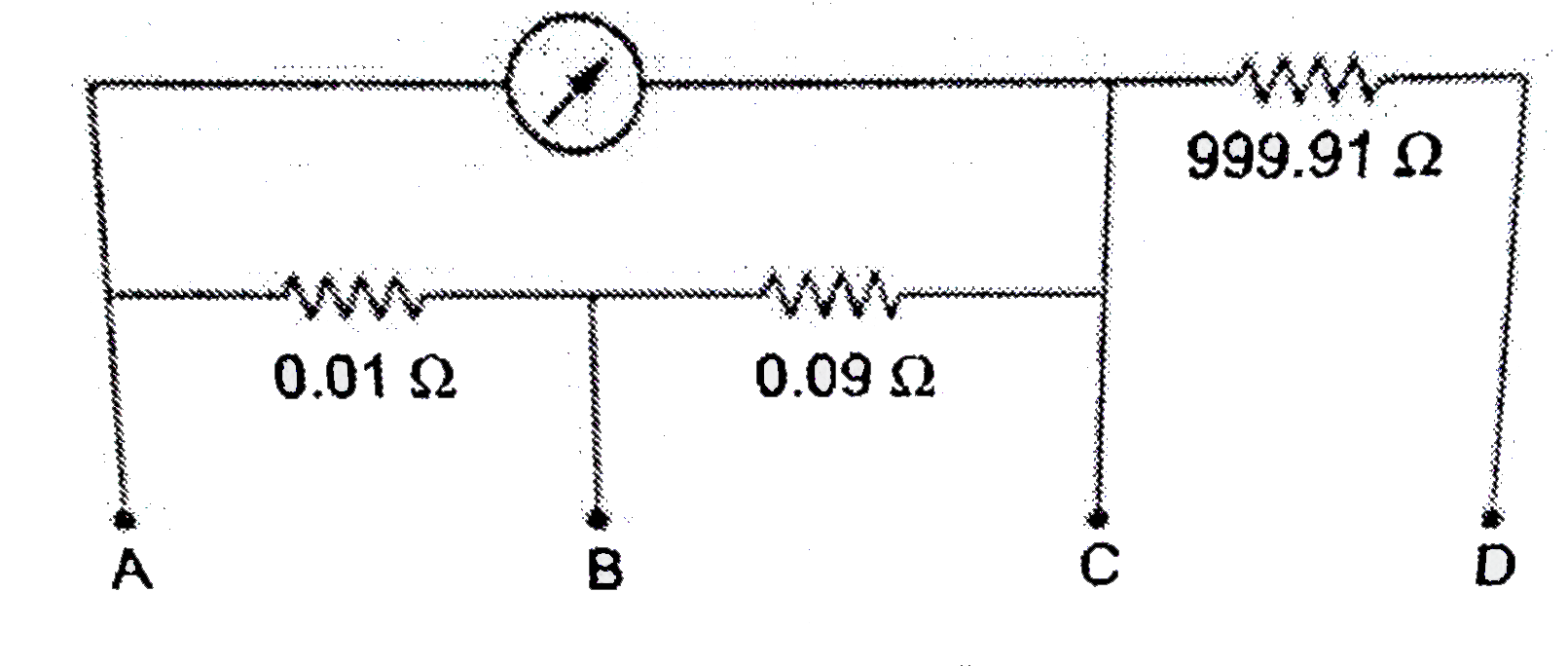Electrical multimeters, or multitesters, are widely used by technicians when working with electrical and electronic circuits. In this instrument, a single milliammeter connected through different resistances is used to measure currents, potential differences and resistance over different ranges.
Current always enters the multimeter at the same terminal, A, and then passes through the milliammeter as well as through other resistances, placed in series with or parallel to it. The choice of the terminal at which current leaves the instrument decides its role (ammeter, voltemeter, etc.) and its range (maximum current or voltage which it can measure).
The milliammeter shown in the circuit has a coil (or internal ) resistance of 0.9ω and gives the full-scale deflection for a current of 10mA.

If A and D are used as the terminals of the multimeter , i.e., current eneters at A and leaves at D, it will function as a voltmeter of which range?
1V
10V
100V
It will not function either as a voltmeter or as an ammeter or a milliammeter.
The correct Answer is:C
Topper's Solved these Questions
Similar Questions
Knowledge Check
Electrical multimeters, or multitesters, are widely used by technicians when working with electrical and electronic circuits. In this instrument, a single milliammeter connected through different resistances is used to measure currents, potential differences and resistance over different ranges.
Current always enters the multimeter at the same terminal, A, and then passes through the milliammeter as well as through other resistances, placed in series with or parallel to it. The choice of the terminal at which current leaves the instrument decides its role (ammeter, voltemeter, etc.) and its range (maximum current or voltage which it can measure).
The milliammeter shown in the circuit has a coil (or internal ) resistance of 0.9ω and gives the full-scale deflection for a current of 10mA.

If A and C are used as the terminals of the multimeter, i.e., current enters at A and leaves at C, it will function as an ammeter of rangeA10AB1AC100mAD10mAElectrical multimeters, or multitesters, are widely used by technicians when working with electrical and electronic circuits. In this instrument, a single milliammeter connected through different resistances is used to measure currents, potential differences and resistance over different ranges.
Current always enters the multimeter at the same terminal, A, and then passes through the milliammeter as well as through other resistances, placed in series with or parallel to it. The choice of the terminal at which current leaves the instrument decides its role (ammeter, voltemeter, etc.) and its range (maximum current or voltage which it can measure).
The milliammeter shown in the circuit has a coil (or internal ) resistance of 0.9ω and gives the full-scale deflection for a current of 10mA.

If A and B are used as the terminals of the multimeter, i.e., current enters at A and leaves at B, it will function as an ammeter of rangeA10AB1AC100mAD10mATo measure the current and potential difference of the resistances connected in series in a circuit, we will use
Aammeter and volimeter both in series connectionBammeter and voltmeter both in parallel connectionCammeter in series and voltmeter in parallelDammeter in parallel and voltmeter in series
To measure the current and potential difference of the resistances connected in series in a circuit, we will use
View SolutionTo use the milliammeter of the previous question as a voltmeter of range 10V, a resistance R is placed in series with it. The value of R is
View SolutionA milliammeter of resistance 5 ohm gives a full scale deflection for a current of 15 mA. If the mulliammeter is to be used to measure current upto 1.5 A, then the resistance that must be attached to the milliammeter is
View SolutionA current ofImAis flowing through a resistance of 1000Ω. To measure the potential difference across it, a voltmeter should be used whose resistance is
View SolutionWhen some potential difference V is applied across a resistance R then the work by the electrical field on the charge q to flow through the circuit in time t will be
View Solution
